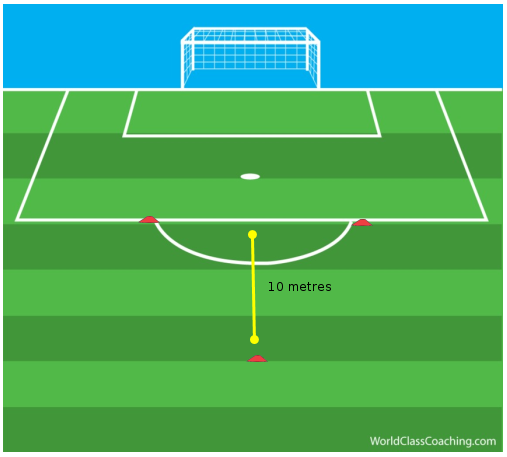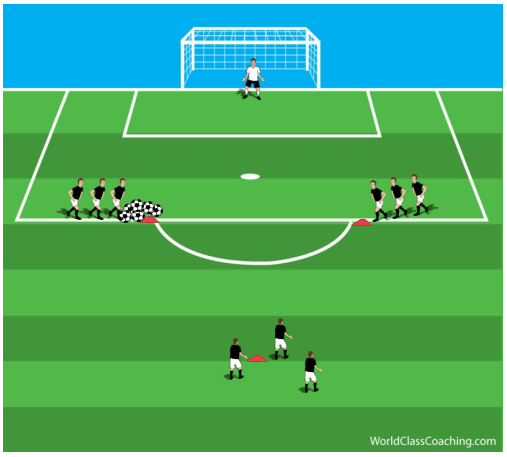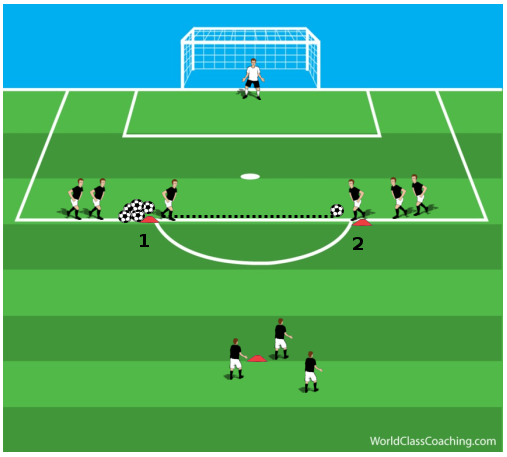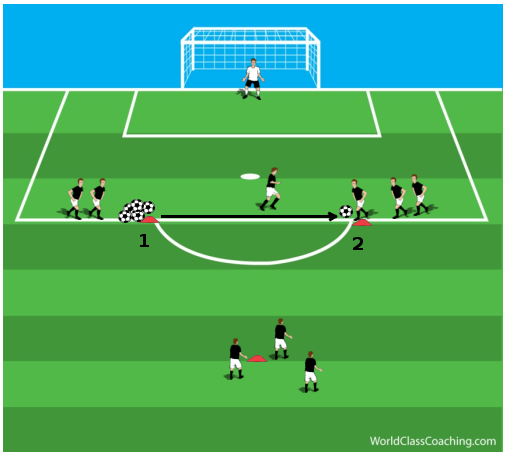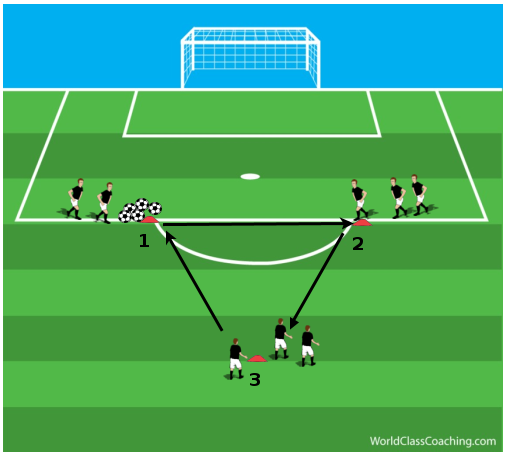By Keith Scarlett
This activity works on finishing, passing, one-touch play and goalkeeping.
Set-up three cones facing one-goal at the top of the box. One cone each should be placed at the point where the field markings form the intersection of the penalty area and “D,” while the third cone should be placed 10 metres out from the edge of the penalty area in a straight line with the penalty spot forming a triangle; per the diagram.
To start this activity, all of the balls should be placed on the “left” cone and the team should be broken up into three different groups with each group being assigned to a different cone, respectively. Goalkeepers are in the goal and are tending the net full-out!
Here’s how it works - The first player in the line at the cone with the balls (1) plays a ball square across the top of the penalty area to the first player in line at the cone directly opposite them (2).
This player then follows their pass at a moderate to quick pace across the face of the goal from cone 1 to cone 2; which is where they initially played the ball.
At the same-time this is occurring, the first player in line at cone 2 should lay the pass off with one-touch back in the direction it came but more negative and at a slight angle so as to fall into the stride of the first player at the third cone (3). This player should be moving forward to strike this one-touch lay-off on goal first-time.
[wpsharely id="2988"][/wpsharely]As soon as a shot is taken the next pass should be played immediately across the face of the goal and the cycle continues.
Players rotate as follows:
A.) Cone 1 plays square ball to Cone 2 and follows their pass across the face of the goal ending up at Cone 2.
B.) Cone 2 lays the pass off one-touch for the shot and then moves to cone 3.
C.) Cone 3 strikes this lay-off first-time, collects their stuff and then begins the process at Cone 1.
Coaching points:
- The first pass is of the utmost importance. It should have pace, be on the floor and played in a manner where their teammate is able to successfully lay-it off for a shot.
- If this first-pass is not of the proper quality, the entire sequence is thrown-off!
- The player at the second cone should be checking-in towards the first pass and opening-up their hips towards the shooter to receive the ball across their body so they can lay it off with their opposite foot (in this scenario; their left-foot) negatively at approximately a 45 degree angle into the shooters stride.
- The texture and weight of this pass is critical to the success of the shooter.
- Communication is needed between players in order to know whether the shooter would like the ball played to their right or left foot.
- Player needs to read the shooters position and ensure their lay-off is played into the shooters stride and so the shooter can strike the ball first-time.
- All shots should be taken from outside of the penalty area, so the lay-off needs to be played back enough for the shot to be taken at least 18 yards out.
- The shooter should work on using proper technique:
- Contact with the instep.
- One-leg motion from the hip-joint generating power from the hip-flexors. The ankle should be locked in plantar-flexion while the knee should be locked at approximately a 30 degree angle thus allowing the only flexion to occur at the hip.
- Follow-through and landing on the striking foot.
- Approach should be natural and in-stride. There should be no hopping, skipping, stutter-stepping or changing of pace upon their approach to the shot.
- They should elevate upon contact with the ball to maximize power and to keep the shot low.
- All shots should be on-frame and players should work on keeping their shots low.
Variations:
- Start all of the balls on the opposite cone and run the same sequence going the opposite direction.
- The first-pass should be chipped/lofted.
- The lay-off should be lifted-up in the air to allow the shooter the opportunity to hit a volley or a half volley.
- The player who lay-offs the ball for the shooter, peels-off after the pas and follow the shot to finish any rebounds.
- Make two teams. One team sets-up at the three cones to run the activity as normal while the other team goes behind the goal. The team behind the goal must stay off the itch and cannot cross over the end line.
Make it a competition where each team gets two minutes to run through the shooting pattern and score as many goals as possible. Each goal scored counts as one point. However, in order to emphasize the focus on keeping all shots low and on frame, any shot that is caught out of the air (before it hits the ground) and behind the end line by the opposing team who are positioned behind the goal will earn that team a point. So, each team can earn points either shooting or being behind the goal.
- Teams get two minutes per round to score as many goals as possible before switching with the other team.
- Goals only count if the first player follows their pass.
- Goals only count if the second player lays the ball off one-touch.
- Goals only count if the shooter hits the shot one-time.
- A shot can be caught out of the air and a point scored for that team even if the shot is a fault due to multiple touches or not following the pass.
By Keith Scarlett, Assistant Women's Football Coach, Perth Glory FC
http://keithscarlett.blogspot.com
Twitter - @keithscarlett

